-
 Bitcoin
Bitcoin $101,898.5005
-0.75% -
 Ethereum
Ethereum $2,258.1125
-1.07% -
 Tether USDt
Tether USDt $1.0004
0.01% -
 XRP
XRP $2.0178
-2.93% -
 BNB
BNB $624.0243
-1.53% -
 Solana
Solana $134.3298
-0.90% -
 USDC
USDC $0.9999
0.01% -
 TRON
TRON $0.2675
-2.05% -
 Dogecoin
Dogecoin $0.1538
-1.96% -
 Cardano
Cardano $0.5482
-1.11% -
 Hyperliquid
Hyperliquid $35.5636
5.45% -
 Bitcoin Cash
Bitcoin Cash $453.4902
-1.66% -
 Sui
Sui $2.5134
-2.97% -
 UNUS SED LEO
UNUS SED LEO $9.1292
1.77% -
 Chainlink
Chainlink $11.8457
-1.60% -
 Stellar
Stellar $0.2312
-2.73% -
 Avalanche
Avalanche $16.9721
0.29% -
 Toncoin
Toncoin $2.7549
-3.82% -
 Shiba Inu
Shiba Inu $0.0...01081
-1.10% -
 Litecoin
Litecoin $80.8250
-0.71% -
 Hedera
Hedera $0.1374
0.21% -
 Monero
Monero $305.4827
-2.36% -
 Ethena USDe
Ethena USDe $1.0006
0.00% -
 Dai
Dai $1.0000
-0.01% -
 Polkadot
Polkadot $3.2085
-3.12% -
 Bitget Token
Bitget Token $4.0845
-3.13% -
 Uniswap
Uniswap $6.3353
-1.63% -
 Pi
Pi $0.5085
-0.70% -
 Pepe
Pepe $0.0...08913
-3.82% -
 Aave
Aave $232.7090
-0.58%
Should the RSI fall back quickly from above 70 to 50?
A rapid RSI drop from 70 to 50 in crypto often signals cooling momentum, not necessarily a reversal—watch for context, volume, and other indicators to confirm trend shifts.
Jun 23, 2025 at 10:49 am
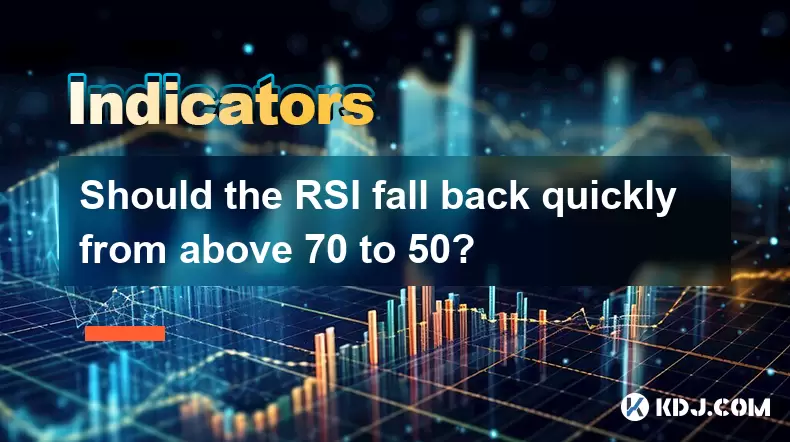
Understanding the RSI Indicator in Cryptocurrency Trading
The Relative Strength Index (RSI) is a momentum oscillator commonly used in cryptocurrency trading to measure the speed and change of price movements. It ranges from 0 to 100 and is primarily used to identify overbought or oversold conditions in an asset. In crypto markets, where volatility is high and trends can shift rapidly, understanding how RSI behaves is crucial for making informed decisions.
Overbought levels are generally considered to be above 70, while oversold levels fall below 30. However, it's important to note that these thresholds aren't always reliable indicators of immediate reversals. The RSI falling quickly from above 70 to 50 might suggest a cooling off period after a strong rally, but not necessarily a reversal.
What Does a Rapid RSI Drop from 70 to 50 Indicate?
When the RSI drops swiftly from above 70 to around 50, it typically signals a loss of upward momentum. This kind of movement often occurs after a sharp price surge, especially during bullish pump phases common in altcoin markets. The rapid decline indicates that buying pressure has diminished, and traders may be taking profits or reducing exposure.
In such cases, the market isn’t necessarily bearish yet, as the RSI settling at 50 suggests neutral momentum. A quick drop like this could also indicate consolidation before another potential move. Traders should look for additional confirmation through volume patterns, candlestick formations, or other technical tools to determine whether a trend continuation or reversal is likely.
Why Does the RSI Fall Quickly in Crypto Markets?
Cryptocurrency markets are known for their extreme volatility and emotional trading behavior. When a coin experiences a sudden spike, often driven by social media hype or whale activity, the RSI jumps rapidly into overbought territory. Once the excitement fades or profit-taking begins, the indicator plummets just as fast.
This phenomenon is particularly noticeable in low-cap altcoins that lack deep liquidity. These assets can experience dramatic swings based on relatively small trades. Therefore, a rapid RSI drop from 70 to 50 doesn’t always mean a sell-off is imminent, but rather that short-term enthusiasm has cooled down.
How to Interpret the RSI Drop in Different Market Contexts
- In a Bull Market: A quick drop from 70 to 50 might signal a healthy pullback within a larger uptrend. Traders may view this as a potential entry point.
- In a Bear Market: A similar drop could indicate weak rallies followed by renewed selling pressure, suggesting that the downtrend remains intact.
- In a Sideways Market: The RSI fluctuating around 50 might reflect indecision among traders and a lack of clear direction.
It’s essential to evaluate the broader market structure and context before drawing conclusions from RSI readings alone. Combining RSI with support/resistance levels or moving averages can offer more clarity about the underlying trend.
Using RSI Alongside Other Indicators for Confirmation
Relying solely on RSI can lead to false signals, especially in volatile crypto markets. To improve accuracy, consider combining RSI with:
- Volume indicators: A drop in RSI accompanied by rising volume might confirm a reversal, while declining volume could suggest a temporary pause.
- Moving Averages: Crossovers or retests of key moving averages can help validate RSI-based signals.
- MACD (Moving Average Convergence Divergence): This can provide further insight into momentum shifts and trend strength.
For instance, if RSI falls from 70 to 50 and MACD crosses below its signal line, it strengthens the case for a potential trend reversal or consolidation phase.
Common Misinterpretations of the RSI Drop from 70 to 50
One common mistake among novice traders is assuming that any RSI drop from overbought levels means a reversal is coming. In reality, strong uptrends can sustain elevated RSI values for extended periods. A rapid descent to 50 doesn’t automatically signal a bearish turn—it might simply indicate a pause in the upward movement.
Another misinterpretation is treating every RSI reading in isolation without considering the broader chart pattern or market sentiment. For example, in a strong bull run, a dip to 50 could be a buying opportunity rather than a warning sign.
Frequently Asked Questions (FAQ)
Q: Can the RSI stay above 70 for long periods in crypto?
Yes, especially during strong uptrends or parabolic moves. Extended overbought conditions don't always precede reversals—they can indicate sustained buying pressure.
Q: Is an RSI drop from 70 to 50 a reliable sell signal?
Not necessarily. It depends on the market environment, volume, and other confirming factors. In trending markets, this drop might only indicate a pause rather than a reversal.
Q: Should I use RSI differently for different cryptocurrencies?
Absolutely. High-cap coins like Bitcoin and Ethereum tend to have more stable RSI behavior compared to smaller altcoins. Adjust your strategy based on volatility and liquidity.
Q: How often should I check RSI when monitoring crypto assets?
Check RSI across multiple timeframes—daily for trend analysis, 4-hour or 1-hour for entries, and lower timeframes for precise timing.
Disclaimer:info@kdj.com
The information provided is not trading advice. kdj.com does not assume any responsibility for any investments made based on the information provided in this article. Cryptocurrencies are highly volatile and it is highly recommended that you invest with caution after thorough research!
If you believe that the content used on this website infringes your copyright, please contact us immediately (info@kdj.com) and we will delete it promptly.
- Bitcoin Price Wobbles: Crash Watch and Key Support Levels
- 2025-06-23 16:25:12
- Navigating the Crypto Seas: Charting a Course Through Bull Runs and Bear Markets
- 2025-06-23 16:25:12
- BNB Price Check: Stablecoin Surge vs. Prediction Rollercoaster
- 2025-06-23 14:25:12
- Metaplanet's Bitcoin Bonanza: Holdings Skyrocket Amidst Market Swings
- 2025-06-23 14:25:12
- Global Meltdown, Investors, and Safe Havens: Navigating the Storm
- 2025-06-23 14:30:12
- NFT Sales Snapshot: Guild of Heroes, Polygon, and the Market's Shifting Sands
- 2025-06-23 15:25:12
Related knowledge

How much volume is required for the W-bottom to break through the neckline of the time-sharing chart?
Jun 23,2025 at 04:21pm
Understanding the W-Bottom Pattern in Cryptocurrency TradingThe W-bottom pattern is a popular technical analysis formation used by traders to identify potential bullish reversals. It typically appears at the end of a downtrend and resembles the letter 'W' on price charts. In the context of cryptocurrency trading, where volatility is high and trends shif...

How to read the sideways consolidation after the bottom volume and long positive line?
Jun 23,2025 at 02:28pm
Understanding the Sideways ConsolidationWhen analyzing cryptocurrency charts, sidewards consolidation refers to a phase where prices move within a narrow range without a clear upward or downward trend. This pattern often appears after significant price movements, such as a sharp increase followed by a period of equilibrium between buyers and sellers. In...
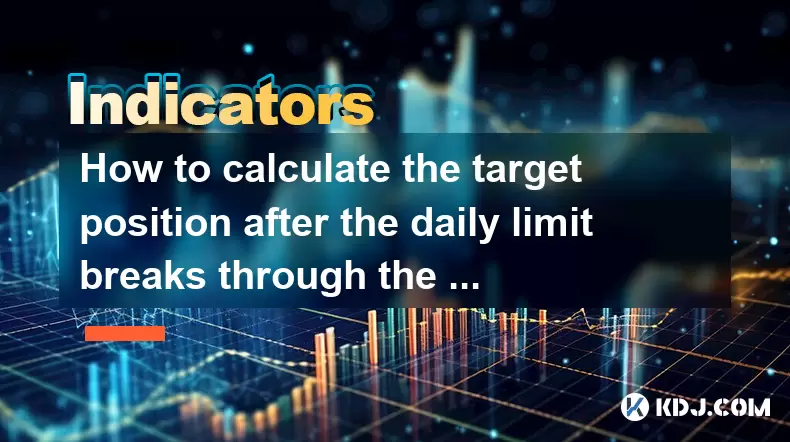
How to calculate the target position after the daily limit breaks through the previous high?
Jun 23,2025 at 02:57pm
Understanding the Daily Limit BreakthroughIn cryptocurrency trading, a daily limit typically refers to the maximum price movement allowed within a single trading day on certain exchanges. When this limit is breached, especially when it surpasses the previous high, traders often seek to calculate the target position or expected price movement following s...
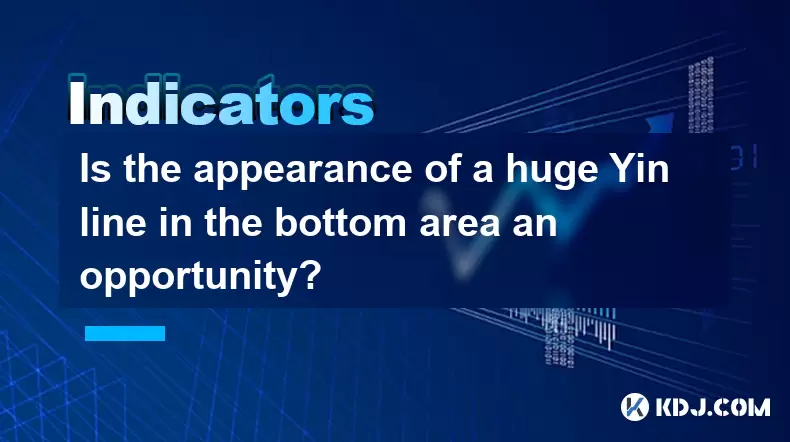
Is the appearance of a huge Yin line in the bottom area an opportunity?
Jun 23,2025 at 04:07pm
Understanding the Meaning of a Huge Yin LineIn technical analysis within the cryptocurrency market, a huge Yin line is often interpreted as a strong bearish signal. It indicates that sellers have dominated the market over a specific period, pushing prices significantly downward. When this occurs in what appears to be a bottom area, traders might questio...
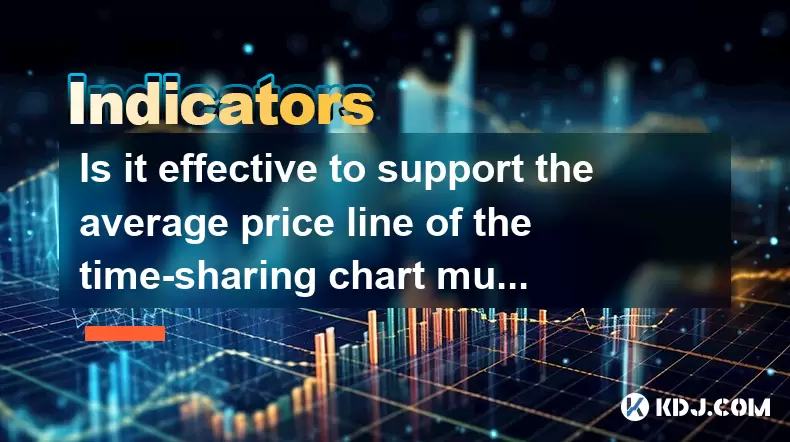
Is it effective to support the average price line of the time-sharing chart multiple times?
Jun 23,2025 at 01:36pm
Understanding the Average Price Line in Time-Sharing ChartsIn cryptocurrency trading, time-sharing charts refer to real-time price charts that display price movements over short intervals, often within a single trading day. Within these charts, the average price line, also known as the Volume Weighted Average Price (VWAP), is a commonly used technical i...
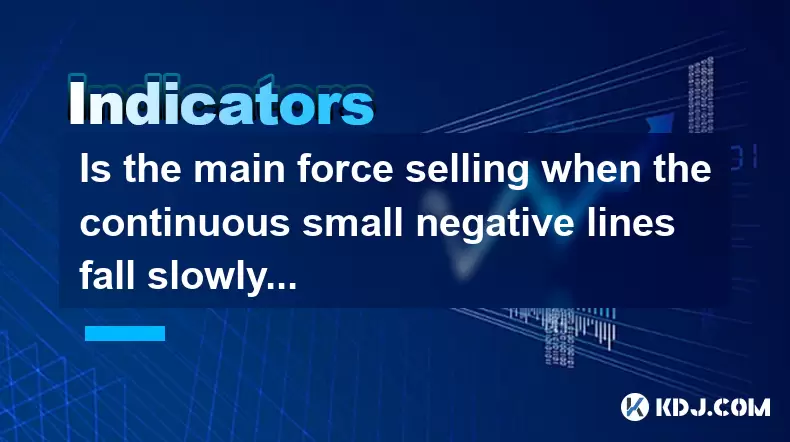
Is the main force selling when the continuous small negative lines fall slowly?
Jun 23,2025 at 03:35pm
Understanding Continuous Small Negative Lines in Cryptocurrency ChartsIn cryptocurrency trading, continuous small negative lines refer to a pattern where the price of an asset declines gradually over time with small bearish candlesticks. These candlesticks typically have short bodies and may or may not have wicks. This pattern often appears during perio...

How much volume is required for the W-bottom to break through the neckline of the time-sharing chart?
Jun 23,2025 at 04:21pm
Understanding the W-Bottom Pattern in Cryptocurrency TradingThe W-bottom pattern is a popular technical analysis formation used by traders to identify potential bullish reversals. It typically appears at the end of a downtrend and resembles the letter 'W' on price charts. In the context of cryptocurrency trading, where volatility is high and trends shif...

How to read the sideways consolidation after the bottom volume and long positive line?
Jun 23,2025 at 02:28pm
Understanding the Sideways ConsolidationWhen analyzing cryptocurrency charts, sidewards consolidation refers to a phase where prices move within a narrow range without a clear upward or downward trend. This pattern often appears after significant price movements, such as a sharp increase followed by a period of equilibrium between buyers and sellers. In...

How to calculate the target position after the daily limit breaks through the previous high?
Jun 23,2025 at 02:57pm
Understanding the Daily Limit BreakthroughIn cryptocurrency trading, a daily limit typically refers to the maximum price movement allowed within a single trading day on certain exchanges. When this limit is breached, especially when it surpasses the previous high, traders often seek to calculate the target position or expected price movement following s...

Is the appearance of a huge Yin line in the bottom area an opportunity?
Jun 23,2025 at 04:07pm
Understanding the Meaning of a Huge Yin LineIn technical analysis within the cryptocurrency market, a huge Yin line is often interpreted as a strong bearish signal. It indicates that sellers have dominated the market over a specific period, pushing prices significantly downward. When this occurs in what appears to be a bottom area, traders might questio...

Is it effective to support the average price line of the time-sharing chart multiple times?
Jun 23,2025 at 01:36pm
Understanding the Average Price Line in Time-Sharing ChartsIn cryptocurrency trading, time-sharing charts refer to real-time price charts that display price movements over short intervals, often within a single trading day. Within these charts, the average price line, also known as the Volume Weighted Average Price (VWAP), is a commonly used technical i...

Is the main force selling when the continuous small negative lines fall slowly?
Jun 23,2025 at 03:35pm
Understanding Continuous Small Negative Lines in Cryptocurrency ChartsIn cryptocurrency trading, continuous small negative lines refer to a pattern where the price of an asset declines gradually over time with small bearish candlesticks. These candlesticks typically have short bodies and may or may not have wicks. This pattern often appears during perio...
See all articles
























































































